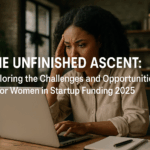Estimated reading time: 8 minutes
Key Takeaways
- AI mega funding rounds dominated Q1 2025 with $59.6 billion in total investment.
- OpenAI secured the largest funding round ever at $40 billion, achieving a $300 billion valuation.
- Major players like Scale AI, xAI, and Anthropic raised billions, cementing their market leadership.
- Investors are concentrating on proven winners rather than early-stage startups.
- North America captured nearly three-quarters of global venture capital in Q1 2025.
- These mega-rounds signal the maturation and consolidation of the AI industry.
Table of contents
2025 has witnessed an unprecedented surge in AI investment, with mega funding rounds reshaping the entire landscape of artificial intelligence development. These massive investment deals, typically exceeding $100 million, represent more than just financial transactions – they’re defining the future of AI innovation and determining which companies will lead the next technological revolution.
A Flood of Capital: The Q1 2025 AI Investment Bonanza
The numbers from the first quarter of 2025 are nothing short of extraordinary. AI companies worldwide raised a staggering $59.6 billion in just three months – a figure that dwarfs most annual investment totals from previous years.
What makes this figure even more remarkable is the concentration of capital. OpenAI alone captured $40 billion of this total, leaving the remaining AI ecosystem to compete for $19.6 billion. Yet even this “remaining” amount exceeded the total venture capital raised by any other industry sector during the same period, highlighting the unprecedented investor appetite for AI solutions.
“The AI investment landscape in Q1 2025 represents a fundamental shift in how venture capital flows, with mega-rounds becoming the new normal rather than the exception.”
The Titans of AI: Who Scored the Biggest Funds?
OpenAI: The Unrivaled King
OpenAI’s record-breaking $40 billion funding round has established a new benchmark for AI investment. This massive influx of capital has pushed the company’s valuation to an astronomical $300 billion, making it one of the most valuable private companies in history.
The investment consortium reads like a who’s who of tech and finance: Microsoft, SoftBank, Founders Fund, and Magnetar Capital. This backing demonstrates the institutional confidence in OpenAI’s vision for artificial general intelligence and its current market-leading position in foundation models.
Scale AI: The Data Infrastructure Powerhouse
While OpenAI captures headlines for its consumer-facing AI models, Scale AI secured $14.3 billion to build the critical infrastructure that makes AI possible. With Meta as a leading investor, Scale AI’s $29 billion valuation reflects the market’s recognition that high-quality training data is the foundation of AI success.
Scale AI specializes in data labeling and infrastructure services – the unglamorous but essential work of preparing and organizing the massive datasets that AI models need to learn effectively.
xAI: Elon Musk’s Bold Vision
Elon Musk’s xAI raised $10 billion in its latest funding round, building on an already impressive $80 billion valuation. Morgan Stanley led this investment, betting on Musk’s track record of disrupting established industries and his vision for developing truth-seeking AI systems.
Anthropic: The Safety-First Competitor
Positioning itself as a responsible alternative to OpenAI, Anthropic secured $3.5 billion in funding, reaching a $61.5 billion valuation. With backing from Lightspeed, Salesforce Ventures, and Google’s parent company Alphabet, Anthropic emphasizes AI safety and alignment in its development approach.
The Rising Stars
Beyond the headline grabbers, several other companies secured significant funding:
- Infinite Reality raised $3 billion for immersive virtual environments, attracting investors like Sky Sports and WWE
- Safe Superintelligence secured $2 billion with backing from Greenoaks and Alphabet, focusing on AI alignment and safety
- Groq raised $1.5 billion for AI hardware acceleration, with notable investment from Saudi Arabia
- Anysphere brought in $900 million for next-generation foundation models, supported by Thrive Capital and a16z
Shifting Tides: The Big Trends in AI Funding
The prevalence of mega-rounds in AI funding signals a fundamental shift in venture capital strategy. Investors are increasingly concentrating their bets on proven performers rather than spreading risk across numerous early-stage startups.
This trend reflects several key market dynamics:
- Market Maturation: The AI industry is transitioning from experimental to commercial viability
- Resource Requirements: Building competitive AI models requires enormous computational resources and talent
- Winner-Take-All Dynamics: Network effects and scale advantages create natural monopolies
- Institutional Validation: Large funding rounds attract additional institutional interest
North America dominated global venture capital in Q1 2025, capturing nearly three-quarters of the $83 billion raised worldwide. This geographic concentration underscores the region’s continued leadership in AI innovation and talent density.
“The shift toward mega-rounds represents a strategic recalibration by investors who recognize that AI leadership requires unprecedented scale and resources.”
The Future is AI-Powered: What These Mega Rounds Mean
The massive scale of these AI mega funding rounds carries profound implications for the technology landscape:
Market Consolidation
These funding rounds are accelerating industry consolidation, with well-funded giants increasingly positioned to dominate key AI infrastructure and foundation models. This creates significant barriers to entry for new competitors who lack similar resource access.
Infrastructure Investment
Much of this funding is flowing toward computational infrastructure, data centers, and specialized hardware. Companies like Mistral, which is seeking nearly $1 billion to build European data center capacity, exemplify this trend toward infrastructure-heavy investments.
Global Competition
The concentration of AI funding in North America is spurring competitive responses from other regions. European initiatives and Asian investments are increasing as governments recognize AI leadership as strategically critical for economic competitiveness.
Innovation Direction
These mega-rounds are directing innovation toward specific areas: foundation models, AI safety, enterprise infrastructure, and specialized applications. The funding distribution suggests where investors believe the most valuable opportunities lie.
Frequently Asked Questions
What qualifies as an AI mega funding round?
An AI mega funding round typically refers to investment deals exceeding $100 million. However, in 2025’s supercharged market, many observers consider rounds above $500 million as truly “mega” given the unprecedented scale of recent deals.
Why are investors pouring so much money into AI companies?
Investors believe AI represents a fundamental technological shift comparable to the internet or mobile computing. The potential for AI to transform every industry, combined with early commercial success from companies like OpenAI, has created enormous investor confidence in long-term returns.
What risks do these mega funding rounds create?
The concentration of funding in a few large companies creates potential risks including market monopolization, reduced innovation diversity, and increased vulnerability to market corrections. Additionally, the massive valuations may prove difficult to justify if AI adoption proceeds more slowly than expected.
How do these funding rounds affect smaller AI startups?
While mega-rounds dominate headlines, they create challenges for smaller startups by raising the bar for competitive infrastructure and talent acquisition. However, they also validate the AI market and can create opportunities for specialized niche players and those serving specific vertical markets.
What should we expect for the rest of 2025?
Based on Q1 trends, we can expect continued large funding rounds, though possibly at a more moderate pace than the record-setting first quarter. Key areas likely to attract significant investment include AI safety, enterprise applications, and international expansion efforts.



